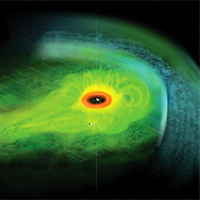Solar & Battery Fan DIY STEM Kit
$9.99$5.95
Posted on: May 4, 2013

This is an artist's concept of the Saturnian plasma sheet based on data from Cassini magnetospheric imaging instrument. It shows Saturn's embedded 'ring current,' an invisible ring of energetic ions trapped in the planet's magnetic field.
Saturn is at the center, with the red 'donut' representing the distribution of dense neutral gas outside Saturn's icy rings. Beyond this region, energetic ions populate the plasma sheet to the dayside magnetopause filling the faintly sketched magnetic flux tubes to higher latitudes and contributing to the ring current. The plasma sheet thins gradually toward the nightside. The view is from above Saturn's equatorial plane, which is represented by grid lines. The moon Titan's location is shown for scale. The location of the bow shock is marked, as is the flow of the deflected solar wind in the magnetosheath.
Image credit: NASA/JPL/JHUAPL
Researchers working with data from NASA's Cassini spacecraft have discovered one way the bubble of charged particles around Saturn -- known as the magnetosphere -- changes with the planet's seasons. The finding provides an important clue for solving a riddle about the planet's naturally occurring radio signal. The results might also help scientists better understand variations in Earth's magnetosphere and Van Allen radiation belts, which affect a variety of activities at Earth, ranging from space flight safety to satellite and cell phone communications.
The paper, just published in the Journal of Geophysical Research, is led by Tim Kennelly, an undergraduate physics and astronomy major at the University of Iowa, Iowa City, who is working with Cassini's radio and plasma wave science team.
In data collected by Cassini from July 2004 to December 2011, Kennelly and his colleagues examined "flux tubes," structures composed of hot, electrically charged gas called plasma, which funnel charged particles in towards Saturn. Focusing on the tubes when they initially formed and before they had a chance to dissipate under the influence of the magnetosphere, the scientists found that the occurrence of the tubes correlates with radio wave patterns in the northern and southern hemisphere depending upon the season. This seasonal effect is roughly similar to the way Earth's northern lights appear more frequently in the spring and autumn months.
Radio emissions have been used to measure Jupiter's rotation period reliably, and scientists thought it would also help them determine Saturn's rotation period. To their chagrin, however, the pattern has varied over the visits by different spacecraft and even in radio emissions originating in the northern and southern hemispheres. The new results could help scientists hone in on why these signals vary the way they do.
 'In a way science is a key to the gates of heaven, and the same key opens the gates of hell, and we do not have any instructions as to which is which gate.
Shall we throw away the key and never have a way to enter the gates of heaven? Or shall we struggle with the problem of which is the best way to use the key?'
'In a way science is a key to the gates of heaven, and the same key opens the gates of hell, and we do not have any instructions as to which is which gate.
Shall we throw away the key and never have a way to enter the gates of heaven? Or shall we struggle with the problem of which is the best way to use the key?'